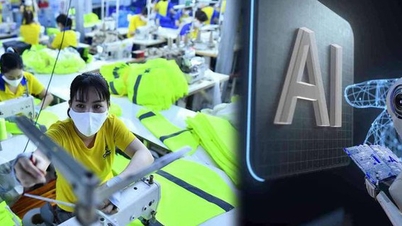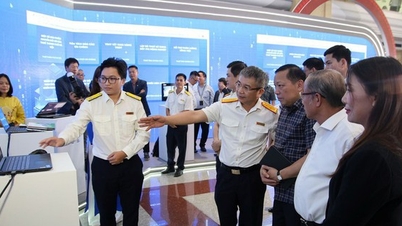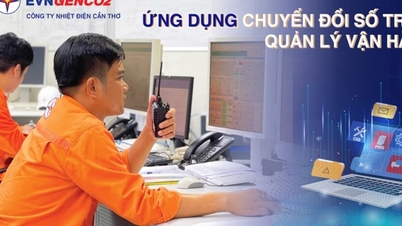Dual transformation – many goals, many challenges
VCCI Vice President Hoang Quang Phong emphasized that in the era of the 4.0 Industrial Revolution and deep integration, digital transformation and green transformation are not only a temporary requirement, but also a core strategy to help businesses improve their competitiveness, expand their markets and ensure long-term development. The goals of reducing emissions, optimizing operations and upgrading production quality are no longer reference options, but have become conditions for businesses to survive in the global supply chain.
According to the Ministry of Industry and Trade , the application of digital technology combined with smart energy management systems can help businesses reduce operating costs by 10-15%, increase productivity by 20% and reduce CO₂ emissions by 5-8% each year. Along with that, McKinsey & Company estimates that digital transformation in manufacturing can help increase labor productivity by about 30% and cut costs in the supply chain by 15-20%. This shows that dual transformation is not only a technological solution, but also a key driving force for businesses to grow sustainably.
Sharing the same view, Director of the Department of Science - Technology, Innovation and Digital Transformation (Central Policy and Strategy Committee) Nguyen Hong Hien affirmed that growth rate is only truly valuable when supported by a sustainable foundation and the key to achieving that is dual transformation.

Photo collection.
According to Mr. Hien, digital transformation helps businesses expand their scale, reduce costs and improve customer experience, while green transformation brings benefits of energy saving, emission reduction and meeting increasingly strict ESG standards from the international market.
However, this process also reveals many challenges. Many enterprises, especially small and medium enterprises, are still limited in financial resources, human resources with digital skills and access to technology. Slow-changing corporate culture, traditional management thinking, and lack of investment efficiency measurement mechanisms make many enterprises hesitant to implement dual transformation.
From the practical perspective of the business community, Vice President and General Secretary of the Vietnam Textile and Apparel Association Truong Van Cam shared that dual conversion is a mandatory path for export enterprises because the US, EU, and Japanese markets all have strict requirements on traceability, environment, and carbon emissions. However, many enterprises still face difficulties in technical standards, lack of technology human resources, lack of support policies on capital and investment procedures, as well as slow tax refund processing time, affecting cash flow.
For small and medium enterprises, these challenges are even greater. Vice President of the Hanoi Association of Small and Medium Enterprises Mac Quoc Anh said that many enterprises lack technology human resources, have financial constraints and do not have an effective measurement system, so they are reluctant to invest. In addition, strategic awareness and innovation culture in enterprises are still major barriers.
From policy to implementation - need synchronous and substantial push
In terms of policy, Resolution No. 57-NQ/TW and Resolution No. 68-NQ/TW have clearly identified promoting innovation, digital transformation and green transformation as pillars of growth, aiming for Vietnam to become a high-income developed country by 2045. However, according to many experts, the gap between policy and actual implementation is still significant.
Director of the Department of Startups and Technology Enterprises (Ministry of Science and Technology) Pham Hong Quat said that dual transformation is not only about applying technology, but also about transforming the business model. Therefore, the decisive factor lies in the awareness and capacity of the leader. Technology is just a tool, while leadership thinking is the driving force. Enterprises must understand what they want to change, where to optimize and choose the right technology. "Without innovative thinking, digital transformation or green transformation is just a formality, easy to be costly but not effective" - Mr. Pham Hong Quat expressed his opinion.
From an industry perspective, many dual conversion models are being effectively implemented. VICEM has taken advantage of excess heat in production, developed rooftop solar power, incinerated industrial waste at high temperatures to thoroughly treat and reduce emissions, and researched the use of dredged sludge as an alternative raw material. However, businesses still need stronger incentive and support mechanisms to expand the scale of green production.
From the perspective of supporting the spread of technology, Senior Lieutenant Colonel Nguyen Dinh Tuan - Deputy General Director of Mobifone said that enterprises are promoting the application of AI in management, energy control, productivity improvement and aiming to popularize AI to small and medium enterprises through digital infrastructure. This will help narrow the gap in resources between large enterprises and SMEs.
Meanwhile, Nguyen Doan Ket, Vice Chairman of the Board of Directors and Deputy General Director of Rang Dong Light Bulb and Vacuum Flask Joint Stock Company, said that it is necessary to build an open innovation model combining institutes, schools and enterprises, creating technology trading floors for small and medium enterprises to access suitable solutions at reasonable costs.
In terms of long-term policy, Director of the Department of Science - Technology, Innovation and Digital Transformation (Central Strategic Policy Committee) Nguyen Hong Hien said that to promote dual transformation, the State needs to focus on three groups of long-term policies. The first is to perfect institutions and standards, especially the legal framework on digital assets, carbon standards and incentive mechanisms for green - digital technology investment, to create a transparent and stable environment for businesses. The second is to develop digital infrastructure and modern energy infrastructure, along with green credit packages and innovation support funds so that businesses, especially small and medium-sized enterprises, can access resources. Finally, to build a "hybrid" human resource with digital and sustainable thinking, through the linkage of institutes - schools - businesses, to ensure that transformation takes place substantially and long-term.
Source: https://mst.gov.vn/go-diem-nghen-de-doanh-nghiep-but-pha-chuyen-doi-kep-197251108172402827.htm






































![[Video] Hue Monuments reopen to welcome visitors](https://vphoto.vietnam.vn/thumb/402x226/vietnam/resource/IMAGE/2025/11/05/1762301089171_dung01-05-43-09still013-jpg.webp)
















































![Dong Nai OCOP transition: [Part 2] Opening new distribution channel](https://vphoto.vietnam.vn/thumb/402x226/vietnam/resource/IMAGE/2025/11/09/1762655780766_4613-anh-1_20240803100041-nongnghiep-154608.jpeg)












Comment (0)